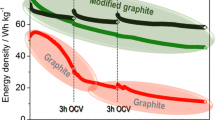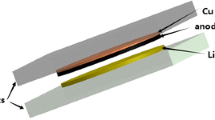Abstract
Lithium-ion capacitors utilizing graphite (G) and reduced graphite oxide (RGO) as negative electrode materials were investigated. Various reduction methods of graphite oxide were applied to compare properties of modified materials. The hybrid cells showed the energy density at mild current regimes of ca. 70–100 Wh/kg. However, at higher rates, only the capacitor with chemically RGO maintained this tendency. Moreover, the system demonstrated the energy density of 34 Wh/kg at a power density of 26 kW/kg. The electrochemical measurements were conducted in three-electrode systems to record responses of positive and negative electrodes separately.










Similar content being viewed by others
References
D. Cericola and R. Kötz: Hybridization of rechargeable batteries and electrochemical capacitors: principle and limits. Electrochim. Acta 72, 1 (2012).
S.R. Sivakkumar and A.G. Pandolfo: Carbon nanotubes/amorphous carbon composites as high-power negative electrodes in lithium ion capacitors. J. Appl. Electrochem. 44, 105 (2014).
X. Wang and G. Shen: Intercalation pseudo-capacitive TiNb2O7@carbon electrode for high-performance lithium ion hybrid electrochemical super-capacitors with ultrahigh energy density. Nano Energy 15, 104 (2015).
G.G. Amatucci, F. Badway, A. Du Pasquier, and T. Zheng: An asymmetric hybrid nonaqueous energy storage cell. J. Electrochem. Soc. 148, A930 (2001).
W.J. Cao, J. Shih, J.P. Zheng, and T. Doung: Development and characterization of Li-ion capacitor pouch cells. J. Power Sources 257, 388 (2014).
X. Sun, X. Zhang, H. Zhang, N. Xu, K. Wang, and Y. Ma: High performance lithium-ion hybrid capacitors with pre-lithiated hard carbon anodes and bifunctional cathode electrodes. J. Power Sources 270, 318 (2014).
J. Zhang, Z. Shi, J. Wang, and J. Shi: Composite of mesocarbon microbe-ads/hard carbon as anode material for lithium ion capacitor with high electrochemical performance. J. Electroanal. Chem. 747, 20 (2015).
N. Ogihara, Y. Igarashi, A. Kamakura, K. Naoi, Y. Kusachi, and K. Utsugi: Disordered carbon negative electrode for electrochemical capacitors and high-rate batteries. Electrochim. Acta 52, 1713 (2006).
V. Khomenco, E. Raymundo-Piñero, and F. Béguin: High-energy density graphite/AC capacitor in organic electrolyte. J. Power Sources 177, 643 (2008).
W.J. Cao and J.P. Zheng: Li-ion capacitors with carbon cathode and hard carbon/stabilized lithium metal powder anode electrodes. J. Power Sources 213, 180 (2012).
M. Schroeder, M. Winter, S. Passerini, and A. Balducci: On the cycling stability of lithium-ion capacitors containing soft carbon as anodic material. J. Power Sources 238, 388 (2013).
K. Naoi, S. Ishimoto, J. Miyamoto, and W. Naoi: Second generation ‘nanohybrid supercapacitor’: evolution of capacitive energy storage devices. Energy Environ. Sci. 5, 9363 (2012).
C. Decaux, G. Lota, E. Raymundo-Pinero, E. Frąckowiak, and F. Béguin: Electrochemical performance of a hybrid lithium-ion capacitor with a graphite anode preloaded from lithium bis(trifluoromethane)sulfonimide-based electrolyte. Electrochim. Acta 86, 282 (2012).
W.S. Hummers and R.E. Offeman: Preparation of graphitic oxide. J. Am. Chem. Soc. 80, 1339 (1958).
M. Galinski and I. Acznik: Study of a graphene-like anode material in N-methyl-N-propylpyrrolidinium bis(trifluoromethanesulfonyl)imide ionic liquid for Li-ion batteries. J. Power Sources 216, 5 (2012).
M.S. Dresselhaus, A. Jorio, and R. Saito: Characterizing graphene, graphite, and carbon nanotubes by Raman spectroscopy. Annu. Rev. Condens. Matter Phys. 1, 89 (2010).
A.C. Ferrari, J.C. Meyer, V. Scardaci, C. Casiraghi, M. Lazzeri, F. Mauri, S. Piscanec, D. Jiang, K.S. Novoselov, S. Roth, and A.K. Geim: Raman spectrum of graphene and graphene layers. Phys. Rev. Lett. 97, 187401 (2006).
J. Jagiello and J.P. Olivier: 2D-NLDFT adsorption models for carbon slit-shaped pores with surface energetical heterogeneity and geometrical corrugation. Carbon 55, 70 (2013).
J. Jagiello and J.P. Olivier: Carbon slit pore model incorporating surface energetical heterogeneity and geometrical corrugation. Adsorption 19, 777 (2013).
S. Stankovich, D.A. Dikin, R.D. Piner, K.A. Kohlhaas, A. Kleinhammes, Y. Jia, Y. Wu, S.T. Nguyen, and R.S. Ruoff: Synthesis of graphene-based nanosheets via chemical reduction of exfoliated graphite oxide. Carbon 45, 1558 (2007).
G. Srinivas, Y. Zhu, R. Piner, N. Skipper, M. Ellerby, and R. Ruoff: Synthesis of graphene-like nanosheets and their hydrogen adsorption capacity. Carbon 48, 630 (2010).
S.J. An, J. Li, C. Daniel, D. Mohanty, S. Nagpure, and D.L. Wood III: The state of understanding of the lithium-ion-battery graphite solid electrolyte interphase (SEI) and its relationship to formation cycling. Carbon 105, 52 (2016).
Author information
Authors and Affiliations
Corresponding author
Rights and permissions
About this article
Cite this article
Acznik, I., Lota, K. & Sierczyńska, A. Improvement of power–energy characteristic of the lithium-ion capacitor by structure modification of the graphite anode. MRS Communications 7, 245–252 (2017). https://doi.org/10.1557/mrc.2017.31
Received:
Accepted:
Published:
Issue Date:
DOI: https://doi.org/10.1557/mrc.2017.31




